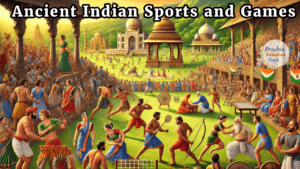
Ancient Indian Sports and Games
The rich cultural heritage of India is extended beyond its art, architecture, and literature to include the vibrant realm of sports and games. The diverse array of physical and mental games in ancient India, reflecting its traditions, values, and way of life, was long before modern competitive sports gained prominence. These activities were not only served as entertainment but also played a vital role in developing strength, strategy, and community spirit.
“Physical Sports in Ancient India” :-
“Wrestling (Malla-Yuddha)”
In ancient India, wrestling, also known as Malla-Yuddha, was a highly developed sport that combined physical prowess with technique. Wrestlers, admired for their discipline and strength, were known as mallas. Wrestling matches, which often attracted large audiences, were frequently held during festivals and public gatherings.
“Archery (Dhanurvidya)”
Archery held a revered place in Indian culture, particularly as a vital skill for warriors. Epic tales such as the Mahabharata and Ramayana highlight the importance of dhanurvidya. Characters like Arjuna and Ekalavya exemplified unmatched expertise in this art. Archery contests were common and served as a means to train individuals in precision, focus, and patience.
“Mallakhamb”
The sport of Mallakhamb, often referred to as the “gymnastics of ancient India,” involves acrobatic exercises performed on a vertical wooden pole. These exercises, which were designed to enhance flexibility, balance, and core strength, were originated around the 12th century. Mallakhamb is considered a testament to the ingenuity of Indian fitness practices, and its relevance is continued in modern times as a celebrated traditional sport.
“Chaturanga”
Chaturanga, the precursor to modern chess, was a game of strategy and intelligence. The name “chaturanga” translates to “four divisions of the military”—infantry, cavalry, elephants, and chariots—reflecting its origins in military strategy. Kings and scholars enjoyed playing this mental game as a popular pastime. The game of Chaturanga involved strategy and intelligence, making it a favorite among royalty and intellectuals.
“Kabaddi”
Rooted in rural traditions, Kabaddi originated in ancient India, where it was played to enhance teamwork, agility, and stamina. The sport was required to be played by raiding the opponent’s side while holding their breath and returning safely—a combination of physical skill and strategic thinking.
Table of Contents
“Cultural and Religious Significance of Sports” :-
In ancient India, cultural and religious practices were deeply intertwined with sports and games. Competitions in archery, wrestling, and chariot racing were often featured at festivals. Physical strength was celebrated and these events were considered offerings to the gods. For example, yoga, though not considered a sport in the competitive sense, was a physical and spiritual discipline that complemented the athletic pursuits of the time.
“Board Games and Intellectual Pursuits” :-
Dice Games (Aksha Kreeda)
Dice games have been mentioned in Indian epics like the Mahabharata, where the infamous game between the Pandavas and Kauravas altered the course of history. These games, while entertaining, also carried moral lessons about greed and the consequences of one’s actions.
Pachisi
The game of Pachisi, which is known as the “game of kings,” was a board game that required a combination of strategy and luck. It is reputed to have been played on a large scale in royal courts, where live pieces moved on massive boards.
“Role of Sports in Education” :
The gurukul system in ancient India integrated physical education as an essential component. In this system, teachers trained students in activities such as archery, wrestling, and chariot racing to cultivate discipline, courage, and a well-rounded personality. These skills were crucial for warriors and rulers, as they equipped them for battles and leadership positions.
“Reviving Ancient Indian Sports”
Many of these ancient sports, though overshadowed by modern games, are continued to be thrived in certain regions of India. Efforts are being made to revive and promote traditional sports like Mallakhamb, Kabaddi, and wrestling on national and international platforms. For example, Kabaddi has gained immense popularity through leagues and international tournaments, showcasing its timeless appeal.
In general, it can be said that,
Ancient Indian sports and games were not just recreational activities; they shaped a way of life that nurtured physical strength, mental agility, and social cohesion. By exploring these traditions anew, we can reestablish a connection with India’s vibrant cultural heritage and find inspiration from its comprehensive approach to fitness and recreation. In a society that increasingly emphasizes fitness and mindfulness, ancient Indian sports serve as a powerful reminder of the enduring principles of health, discipline, and community spirit.
Ancient Indian Sports and Games Ancient Indian Sports and Games Ancient Indian Sports and Games Ancient Indian Sports and Games Ancient Indian Sports and Games Ancient Indian Sports and Games
